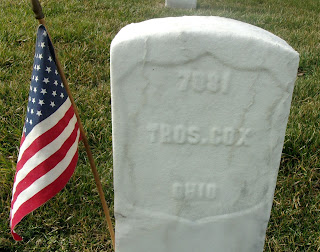Anna Morgan was born on the 20th of September 1846 in Wolverhampton, Staffordshire, England. Her parents were Patrick Morgan and Katherine (Kitty) McAlpine. She is listed on the English Census record of 1861 living with her parents and sisters Mary, 17, and Margaret, 6. At the tender age of 16, Anna married an Irish immigrant, John O'Malley, on September 13, 1863 at the Catholic Chapel on Oxford St., Wolverhampton. Her father, Patrick Moughan (
sic) is listed on the marriage record. Her first three daughters were born here: Mary in 1864, Catherine in 1866, and Sarah in 1867.
During the family's stay in England, a special visitor came to Wolverhampton. In 1866, Her Royal Majesty Queen Victoria arrived to celebrate the unveiling of a statue of her late husband, Prince Albert. The town square was arrayed in bunting with seating for the queen's entourage and special guests, and a portico erected for Her Majesty's comfort. As usual, she was dressed in black as she continued to mourn her great personal loss. I like to think that my working-class family was able to catch a glimpse of the proceedings and be a part of the excitement.
Two years later, in 1868, Anna, her husband, the three girls, sister Margaret and her parents climbed aboard the Clara Wheeler for the lengthy and uncomfortable trip across the Atlantic to the New World. I wonder who introduced the idea to embark on such a life-changing voyage. Was it John's idea? Maybe Patrick wanted a go of it before he got any older? Was Ann excited or too weary after having three babies in three years to care? Or was this the plan all along? We will likely never know.
 |
| Clara Wheeler |
In June, the ship landed at Castle Garden, New York, where the passengers were processed. The Williamsburgh area of Brooklyn became the O'Malley's first stop where they lived until about 1874. Daughters Elizabeth and Margaret, and son John were born here. Sadly, daughter Catherine died of croup in 1869. She was buried in Brooklyn. Between the crowded conditions in the tenement they shared with ten other families, the multiple pregnancies, and the loss of her second child, it was a bumpy beginning to Anna's life in America.
According to the 1875 Minnesota State Census, the O'Malley family had relocated and was living next door to Patrick and Katherine Morgan in Winona. Anna was pregnant again with her seventh child, Kathryn. Then came Ann, Charles, Grace, and finally, May, my grandmother. Her only sons, John and Charles, died as young children. After the death of the boys, they adopted a Norwegian child named 'Johnny' and he, too, died young. John O'Malley would have no sons to carry on the family name.
Anna's next move would be her last. In the spring of 1878, the family took up residence at the homestead they had applied for in Murray County, Minnesota. There they would build a home and farm the land for the rest of Anna's life. I located a story written by a farmer's wife living somewhere in the Midwest called "Farm Wife, 1900" (at www.eyewitnesstohistory.com). The anonymous author describes her typical day on the farm. This is a paraphrased and edited account:
'Up at 4 a.m., start the kitchen fire, sweep the floors, cook breakfast for husband and children, milk the cows, turn the cattle and cows to pasture, fetch water from the spring for the sheep and horse,
feed the pigs and chickens, tend to the children, clean the kitchen, do the churning, hoe out the garden weeds, eat a cold dinner, rest, sow a flower bed, repair a fence, get supper, water the horse, milk the cows, round up the animals for the night, feed chickens and pigs, eat supper, clean up, bed.'
And she only had two children! The idyllic notion of life on a rural farm doesn't match the work that it took to keep body-and-soul together while making a living without the modern conveniences of indoor plumbing or electricity. Not to mention the dreadful Midwest winters. The hard truth of my ancestors' lives leaves me to wonder if I could have been as successful as a mother and farm wife as dear Anna.
 |
| O'Malley Homestead 2010 |
 |
| Death Record |
 |
| Anna Morgan O'Malley |
The family farm was sold in May 1903. One month later, Anna died in a Minneapolis hospital of septicemia after stepping on a rusty nail at the farm. She was buried at Calvary Cemetery in Currie, Murray County. After a lifetime filled with difficult work and the death of five of her thirteen children (not all of their names are known), Anna did not live long enough to enjoy the fruits of retirement and a quieter, more peaceful life. God Bless you, Grandma Anna.












